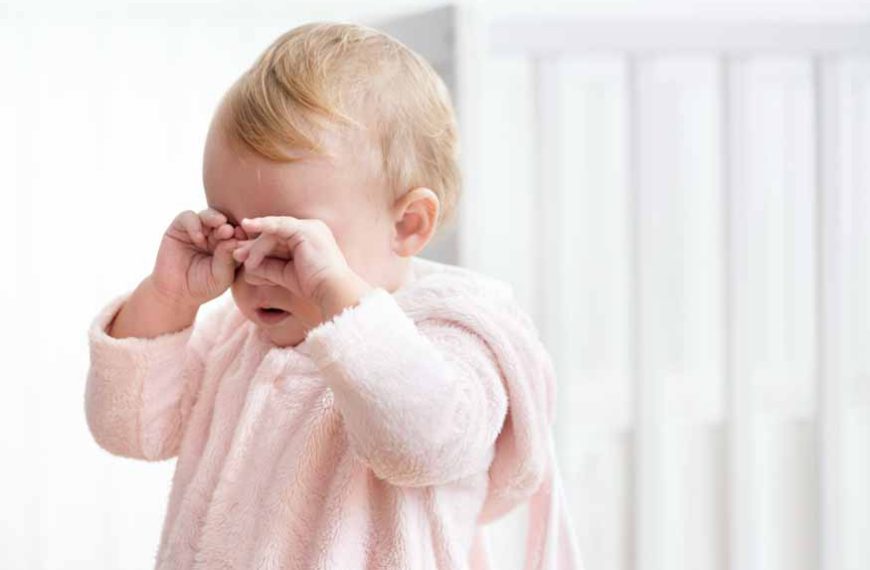Around 20% of newborns may have a watery eye, making it a common condition in babies. Fortunately, this is a normal symptom that goes away on its own. However, occasionally, it may become a matter of concern. This blog post aims to shed light on the various causes contributing to watery eyes in babies, explore treatment options, potential risks, and along with the ways to prevent them.
What Causes Watery Eyes in Babies?
Excessive eye-watering in babies can be caused by a variety of medical issues, including allergies, infections, common cold, and a blocked tear duct. This symptom is also known as epiphora, which refers to excessive tears in the eyes. Some reasons for watery eyes include the following:
- Blocked Tear Ducts
- Eye Infections
- Allergies
- Eyelash or Eyelid Issues
- Common cold
One of the most common causes of watery eyes in infants is blocked tear ducts. This occurs when the ducts that normally drain tears from the eyes are obstructed, leading to a build-up of tears and resulting in excessive tearing.
Infections, such as conjunctivitis (pink eye), can cause watery eyes in babies. Bacterial or viral infections can irritate the eyes, leading to increased tear production.
Environmental allergens, such as dust, pollen, or pet dander, can trigger an allergic reaction in babies, causing watery eyes. Identifying and minimising exposure to allergens can help alleviate symptoms.
Misaligned eyelashes or eyelids can irritate the eyes and cause tearing. Sometimes, eyelashes may grow inward, rubbing against the surface of the eye and leading to excessive tearing.
The watery eyes of your child may also be a sign of a common cold. Since they have not developed an immune system and frequently touch their mouths, noses, and eyes, children are more prone to colds than adults. Your child may experience runny or stuffy nose, sneezing, and watery eyes in addition to other cold symptoms.
Risks of Teary Eyes
If your newborn baby gets Watery-eyed frequently, take him or her to a paediatrician right away. This could be a sign of a more serious condition like conjunctivitis or pink eye. When a bacterial infection causes pink eye in newborns, treatment must be given the same day the symptoms appear. If your infant exhibits any of the following symptoms in addition to watery eyes, it’s serious!!
- Inflammatory response
- A discharge that is either green or yellow
- Redness
- Pain
- Sensitivity to bright light
- Changes in the structure of the eyes or eyelid
- Itching in the eyes (your infant may frequently rub them)
Persistent tearing may lead to corneal damage if left untreated. In rare cases, untreated eye conditions can impact a baby’s visual development. Early detection and intervention are crucial in preventing long-term consequences.
How to Treat Watery Eyes in Babies?
The symptoms of watery eyes usually go away on their own, so your infant might not need treatment at all. However, you may require a prescription medicine to cure the infection.
- Home Remedies to Treat Watery Eyes in Babies
- Medical Treatment
You can use home remedies if your baby’s eyes are white and don’t seem irritated, or if your doctor recommends it. This may involve massaging the blocked tear duct to help it open. This entails using your index finger to rub the outside of your baby’s nose. You may also apply a warm compress to the baby’s eye to help clean it along with offering some comfort.
If your baby’s watery eyes are long-term or they have an infection, you may need to get them medical attention. An antibiotic may be required to treat an infection that develops in a blocked tear duct. Antibiotics must also be used for bacterial conjunctivitis. To remove any accumulation, the doctor could suggest cleaning your baby’s eyes with an isotonic solution.
In case the blocked tear duct fails to resolve on its own, the doctor could suggest surgical probing as a treatment option.
How to Prevent Watery Eyes?
You may prevent your baby from getting watering eyes by taking the steps as follows:
- Maintain Good Hygiene:
- Check for Blockage of Tear Ducts:
- Control Allergies:
- Proper Ventilation:
- Timely Medical Check-ups:
Keep the baby’s hands and toys clean. Anyone suffering from a common cold should not come close to the baby. If so, they ought to thoroughly wash their hands before touching the infant.
Your baby’s tear duct may be clogged at birth. If you see that your infant is constantly crying, take them to the doctor to check out a tear duct blockage.
If you know that your baby suffers from allergies, take every means possible to avoid the allergens that trigger them.
Adequate ventilation in your baby’s living space helps reduce exposure to potential allergens, contributing to overall eye health. Ensure good airflow and cleanliness in your baby’s environment.
Regular visits to the paediatrician allow the early detection of any emerging eye issues. Timely intervention can prevent complications and ensure optimal eye health for your baby.
Frequently Asked Questions (FAQs) About Watery Eyes in Babies
- Q1: What causes watery eyes in babies?
- Q2: How can I treat watery eyes in my baby?
- Q3: Can I prevent watery eyes in my baby?
- Q4: How do I clean my baby’s eyes safely?
- Q5: When should I seek medical attention for my baby’s watery eyes?
Answer: Watery eyes in babies can result from various factors, including congenital tear duct obstruction, eye infections, and allergies. Recognizing the specific cause is important for effective treatment.
Answer: Treatment approaches vary based on the underlying cause. Gentle massage techniques around the tear duct area, antibiotic eye drops for infections, and managing allergen exposure are common methods recommended by paediatricians.
Answer: Yes, proactive prevention strategies include incorporating regular eye hygiene into your baby’s routine, ensuring proper ventilation to minimise allergen exposure, and scheduling timely medical check-ups for early detection and intervention.
Answer: Use a clean, damp cloth to gently wipe away any debris from the corners of your baby’s eyes. Avoid using harsh or scented products and ensure your hands are clean before touching the delicate eye area.
Answer: If you notice persistent or worsening watery eyes, or if your baby shows signs of discomfort, it is advisable to consult with a paediatrician. Early intervention can address underlying issues and prevent complications.
Watery eyes may be caused due to various medical conditions, including allergies, a blocked tear duct, a common cold, and infections. The teary eyes can be a sign of conjunctivitis or pink eye, which should be treated right away if it’s bacterial. Timely intervention can address underlying issues and contribute to the healthy development of a baby’s vision.
As we prioritise our children’s health and growth, it is also vital to provide them with a nurturing and stimulating environment. This brings us to EuroKids, a leading name in early childhood education. EuroKids understands the significance of a child’s formative years and is committed to providing a holistic learning experience.
EuroKids offers a blend of innovative teaching methods, a child-centric curriculum, and a safe, engaging atmosphere. The skilled educators at EuroKids are dedicated to promoting a love for learning in children, ensuring that they develop not only academically but also socially and emotionally.
By enrolling your child at EuroKids, you can give them a head start in their educational journey. Your child deserves the best, and EuroKids is here to make those formative years truly exceptional.















